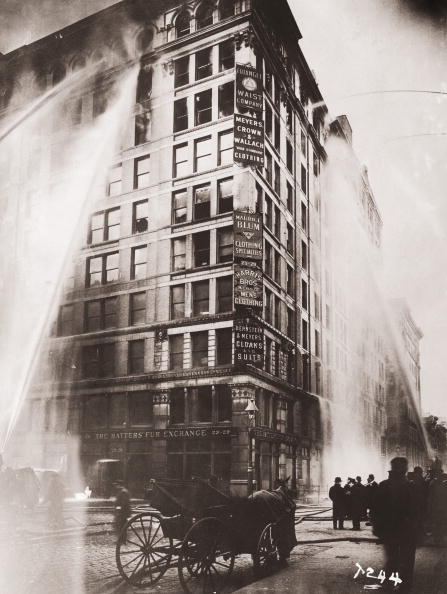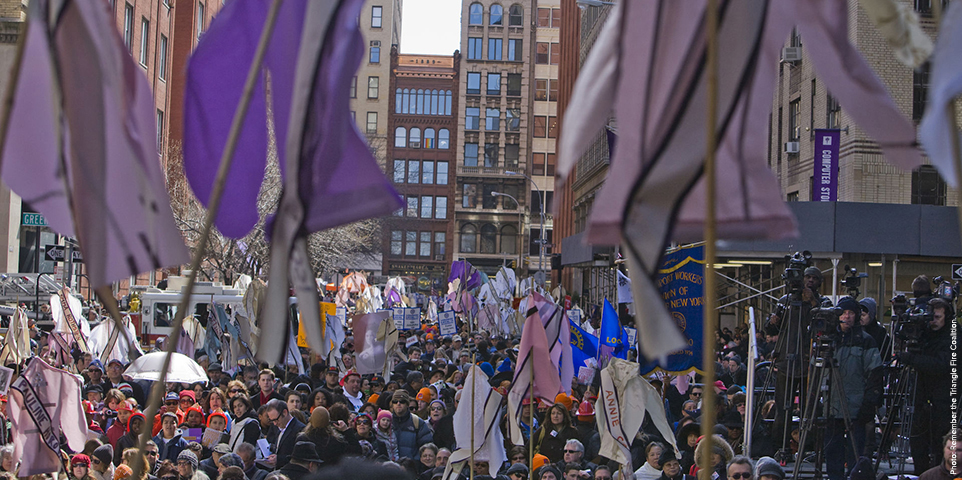
Fire hoses spray water on the upper floors of the Asch Building. (Keystone/Getty Images)
The Triangle Shirt Waist Company Fire, the deadliest workplace disaster in New York City prior to September 11, 2001, occurred on March 25, 1911, and resulted in the death of 146 workers. One hundred and twenty-three of the victims were women, most in their late teens and early 20s. The Triangle Company manufactured ladies’ shirtwaists, a popular garment of the era.
The accidental fire swept through the 8
th, 9
th, and 10
th floors of what was then known as the Asch Building, situated at the intersection of Washington Place and Greene Street, in the Greenwich Village section of Manhattan. Today, New York University’s Brown Building sits on the site, not far from Washington Square Park.

The gutted remains of the tenth floor, with only the floors and walls intact. (Bettmann/CORBIS)
The circumstances surrounding the fire contributed to the enormity of the loss of life, and caused widespread shock at the time. The cramped quarters, long tables and bulky machines trapped many of the victims, and the company’s owners acknowledged locking one of the building’s upper-level doors, which only they could open. Furthermore, the building had only one fire escape, which collapsed during the rescue effort. The public outcry following the fire set into motion dramatic changes in the state laws and regulations regarding workplace safety and risk reduction.
“The Triangle Fire is a searing moment in the historical memory of New York's Italian and Jewish communities," said David Von Drehle, author of
Triangle: The Fire That Changed America (Grove Press, 2003). “Nearly all of the 146 workers killed in the fire were Jewish or Italian immigrants. And I have found that the children, grandchildren, and great-grandchildren of those immigrant communities have had this story passed down through the generations.”

People line up to identify the bodies of victims after the fire. (Hulton Archive/Getty Images)
While innovations such as firewalls, fire doors, fire stairs and automatic sprinklers were already available to Manhattan factory owners, it was virtually impossible to find them anywhere in New York City at the time, according to Von Drehle’s book.
In 1911, Alfred E. Smith, a future New York governor, and Robert F. Wagner Sr., a future U.S. Senator from New York, were the state Assembly majority leader and the head of the state Senate, respectively, and were instrumental in spearheading reforms to workplace safety laws.
Governor John Dix signed into law a bill creating the Factory Investigating Commission on June 30, 1911. Many of the recommendations from that commission were incorporated into legislation in 1912 and 1913. New York State subsequently required automatic sprinklers in high-rise buildings, mandatory fire drills, and factory doors had to be unlocked and swing outward. Moreover, in 1914, New York’s State Insurance Fund (SIF) opened its doors, giving employers the opportunity to purchase workers compensation and disability insurance coverage for their employees. To this day, SIF remains the largest writer of workers compensation insurance in New York State in terms of market share.
VIDEO
Resources
OSHA: Triangle Shirtwaist Fire Factory Page (U.S. Department of Labor, Occupational Safety and Health Administration)
As OSHA celebrates 40 years of protecting workers, we also remember the labor pioneers, safety advocates, community leaders and ordinary workers whose vision for a stronger America laid the foundations for the laws that keep workers safe and healthy today. The 100th anniversary of the Triangle shirtwaist factory fire, which killed 146 workers in a New York City garment factory, marks a century of reforms that make up the core of OSHA's mission. Use this page to learn more about a tragic event that led to a "general awakening" that continues to drive OSHA's commitment to workers.
Remember the Triangle Fire Coalition March 25, 2011 is the Centennial of the infamous Triangle Shirtwaist Factory Fire which took the lives of 146 workers, mostly young immigrant women, and galvanized a movement for social justice. In concert with organizations and individuals across the country, we are spearheading commemorative events – activism, education, arts – for the Centennial and the establishment of a permanent public art memorial.



